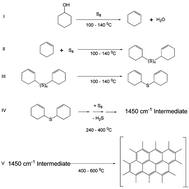Sulfur as an important co-factor in the formation of multilayer graphene in the thermolyzed asphalt reaction
Abstract
The results indicate a first ever hypothesized role of sulfur in the low temperature formation of

* Corresponding authors
a
Department of Chemistry, University of Idaho, Moscow, ID, USA
E-mail:
ifcheng@uidaho.edu
Fax: +1 (208) 885-6387
Tel: +1 (208) 885-6387
b Department of Physics, University of Idaho, Moscow, ID, USA
The results indicate a first ever hypothesized role of sulfur in the low temperature formation of

 Please wait while we load your content...
Something went wrong. Try again?
Please wait while we load your content...
Something went wrong. Try again?
Y. Xie, S. D. McAllister, S. A. Hyde, J. P. Sundararajan, B. A. FouetioKengne, D. N. McIlroy and I. F. Cheng, J. Mater. Chem., 2012, 22, 5723 DOI: 10.1039/C2JM15934A
To request permission to reproduce material from this article, please go to the Copyright Clearance Center request page.
If you are an author contributing to an RSC publication, you do not need to request permission provided correct acknowledgement is given.
If you are the author of this article, you do not need to request permission to reproduce figures and diagrams provided correct acknowledgement is given. If you want to reproduce the whole article in a third-party publication (excluding your thesis/dissertation for which permission is not required) please go to the Copyright Clearance Center request page.
Read more about how to correctly acknowledge RSC content.
 Fetching data from CrossRef.
Fetching data from CrossRef.
This may take some time to load.
Loading related content
